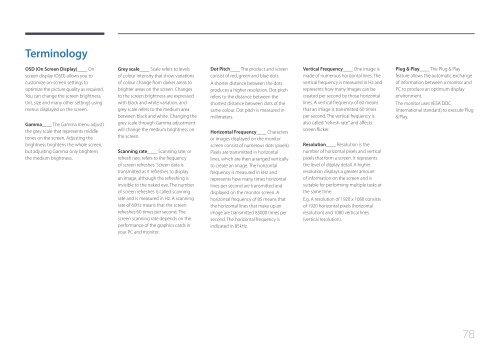Samsung 27" SE370 LED Monitor with Wireless Charging - LS27E370DS/ZA - User Manual ver. (ENGLISH,1.83 MB)
Samsung 27" SE370 LED Monitor with Wireless Charging - LS27E370DS/ZA - User Manual ver. (ENGLISH,1.83 MB)
Samsung 27" SE370 LED Monitor with Wireless Charging - LS27E370DS/ZA - User Manual ver. (ENGLISH,1.83 MB)
You also want an ePaper? Increase the reach of your titles
YUMPU automatically turns print PDFs into web optimized ePapers that Google loves.
Terminology<br />
OSD (On Screen Display)____ On<br />
screen display (OSD) allows you to<br />
customize on-screen settings to<br />
optimize the picture quality as required.<br />
You can change the screen brightness,<br />
tint, size and many other settings using<br />
menus displayed on the screen.<br />
Gamma____ The Gamma menu adjusts<br />
the grey scale that represents middle<br />
tones on the screen. Adjusting the<br />
brightness brightens the whole screen,<br />
but adjusting Gamma only brightens<br />
the medium brightness.<br />
Grey scale____ Scale refers to levels<br />
of colour intensity that show variations<br />
of colour change from darker areas to<br />
brighter areas on the screen. Changes<br />
to the screen brightness are expressed<br />
<strong>with</strong> black and white variation, and<br />
grey scale refers to the medium area<br />
between black and white. Changing the<br />
grey scale through Gamma adjustment<br />
will change the medium brightness on<br />
the screen.<br />
Scanning rate____ Scanning rate, or<br />
refresh rate, refers to the frequency<br />
of screen refreshes. Screen data is<br />
transmitted as it refreshes to display<br />
an image, although the refreshing is<br />
invisible to the naked eye. The number<br />
of screen refreshes is called scanning<br />
rate and is measured in Hz. A scanning<br />
rate of 60Hz means that the screen<br />
refreshes 60 times per second. The<br />
screen scanning rate depends on the<br />
performance of the graphics cards in<br />
your PC and monitor.<br />
Dot Pitch____ The product and screen<br />
consist of red, green and blue dots.<br />
A shorter distance between the dots<br />
produces a higher resolution. Dot pitch<br />
refers to the distance between the<br />
shortest distance between dots of the<br />
same colour. Dot pitch is measured in<br />
millimeters.<br />
Horizontal Frequency____ Characters<br />
or images displayed on the monitor<br />
screen consist of numerous dots (pixels).<br />
Pixels are transmitted in horizontal<br />
lines, which are then arranged <strong>ver</strong>tically<br />
to create an image. The horizontal<br />
frequency is measured in kHz and<br />
represents how many times horizontal<br />
lines per second are transmitted and<br />
displayed on the monitor screen. A<br />
horizontal frequency of 85 means that<br />
the horizontal lines that make up an<br />
image are transmitted 85000 times per<br />
second. The horizontal frequency is<br />
indicated in 85kHz.<br />
Vertical Frequency____ One image is<br />
made of numerous horizontal lines. The<br />
<strong>ver</strong>tical frequency is measured in Hz and<br />
represents how many images can be<br />
created per second by those horizontal<br />
lines. A <strong>ver</strong>tical frequency of 60 means<br />
that an image is transmitted 60 times<br />
per second. The <strong>ver</strong>tical frequency is<br />
also called "refresh rate" and affects<br />
screen flicker.<br />
Resolution____ Resolution is the<br />
number of horizontal pixels and <strong>ver</strong>tical<br />
pixels that form a screen. It represents<br />
the level of display detail. A higher<br />
resolution displays a greater amount<br />
of information on the screen and is<br />
suitable for performing multiple tasks at<br />
the same time.<br />
E.g. A resolution of 1920 x 1080 consists<br />
of 1920 horizontal pixels (horizontal<br />
resolution) and 1080 <strong>ver</strong>tical lines<br />
(<strong>ver</strong>tical resolution).<br />
Plug & Play____ The Plug & Play<br />
feature allows the automatic exchange<br />
of information between a monitor and<br />
PC to produce an optimum display<br />
environment.<br />
The monitor uses VESA DDC<br />
(international standard) to execute Plug<br />
& Play.<br />
78
















